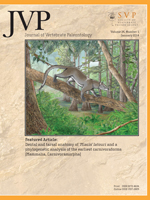Fragmentary anuran remains (an ilium and radioulna) from the middle Miocene of Moratilla 2 (Teruel Province, Spain) are identified, using qualitative characters and geometric morphometrics, as belonging to a new unnamed species of midwife toad, of the extant anuran genus Alytes (Alytidae). The Moratilla 2 fossils of Alytes are dated to ca. 16–17 Ma, prior to the early splits that resulted in the current Alytes diversification. Our biometric study of the fossil radioulnar fragment, an element usually considered uninformative, has revealed convergent adaptive trends in forearm locomotor performance within the genus. This finding would have remained hidden otherwise, because neither molecular approaches nor the comparative osteology of living forms would have detected it. A model for the evolutionary history of midwife toads is proposed, as a case example of how molecular phylogeographic results can be combined with morphological and paleontological studies at the genus level. Historical models of morphological adaptation at low taxonomic and anatomical levels now seem feasible using quantitative reconstructions of fossil fragments. In the future, these models can be compared with independently derived data based on environmental history.
How to translate text using browser tools
1 January 2014
Middle Miocene Remains of Alytes (Anura, Alytidae) as an Example of the Unrecognized Value of Fossil Fragments for Evolutionary Morphology Studies
Markus Bastir,
Madelaine Böhme,
Borja Sanchiz
ACCESS THE FULL ARTICLE





